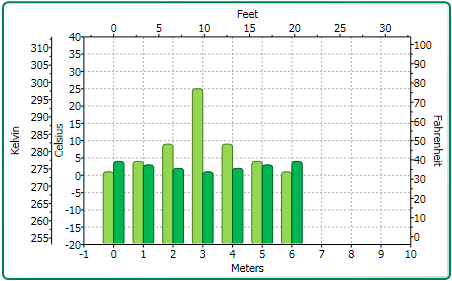
Multiple Axes
Multiple axes are commonly used when you have the following:
•Two or more Data Series that have mixed types of data which make the scales very different
•Wide range of data values that vary from Data Series to Data Series
The following chart uses five axes to effectively display the length and temperature in both metric and non-metric measurements:

You can add multiple axes to the chart by adding a new Axis object and then specifying its type (X, Y, or Z) for the Axis.AxisType property.
The following XAML code shows how to add multiple Y-axes to the chart:
<c1chart:C1Chart Margin="0" Name="c1Chart1">
<c1chart:C1Chart.View>
<c1chart:ChartView>
<!-- Auxiliary y-axes -->
<c1chart:Axis Name="ay2" AxisType="Y" Position="Far" Min="0" Max="10" />
<c1chart:Axis Name="ay3" AxisType="Y" Position="Far" Min="0" Max="20" />
<c1chart:Axis Name="ay4" AxisType="Y" Position="Far" Min="0" Max="50" />
</c1chart:ChartView>
</c1chart:C1Chart.View>
<c1chart:C1Chart.Data>
<c1chart:ChartData>
<c1chart:DataSeries Values="1 2 3 4 5" />
<c1chart:DataSeries AxisY="ay2" Values="1 2 3 4 5" />
<c1chart:DataSeries AxisY="ay3" Values="1 2 3 4 5" />
<c1chart:DataSeries AxisY="ay4" Values="1 2 3 4 5" />
</c1chart:ChartData>
</c1chart:C1Chart.Data>
</c1chart:C1Chart>